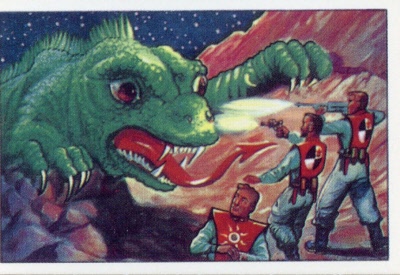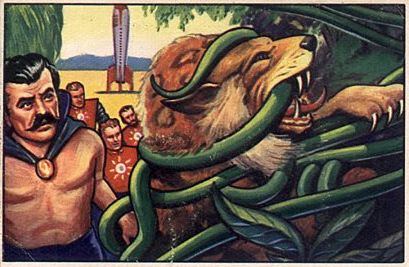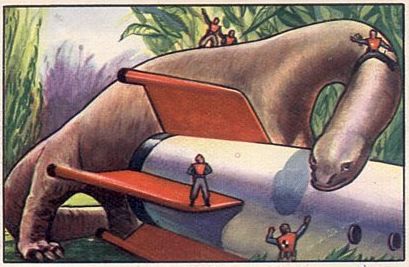Looking Back at J-R-S!
By Kurt
Kuersteiner (© 2007 Monsterwax
Monster Trading Cards) for The
Wrapper Magazine from issue #232



Jets! Rockets! Spacemen! What kid doesn't find at least one of those three subjects fascinating? J. Warren Bowman (President of Bowman Gum Co.) certainly knew how to cater to kids, and Jets-Rockets-Spacemen (a.k.a. JRS) was one of his later and greater bubble gum gems-of-genius. Bowman commissioned the George Moll Advertising agency to produce the artwork for the series. He had used Moll before to create many of his earlier classic card series, including Horrors Of War, War Gum, Lone Ranger, Wild West, and Wild Man cards. The JRS story was written by Gordon Palmer, and the result was a space saga that spanned 180 different cards (or five series of 36 cards).
The dramatic cards hit the market in 1951 in both 1 and 5 cent packs. They were a sensation among kids. The story followed the adventures of the Rocketship 6X52 crew as they left the rocket center in Manhattan and traveled to the moon, Mercury, Mars, and many other planets. Unlike the tedious time-delayed transmissions that came from the real-life Apollo missions, reports from the 6X52 were always action packed. The crew was never bored by the monotony of space travel or visiting lifeless worlds. They sped from planet to planet without growing old and barely had time to sleep! Astro-pirates, Meteorite showers, and even giant space blobs menaced them between destinations. Landing the ship rarely made them any safer. Back in the 1950s, every planet and moon was teaming with life and most of it was hazardous to humans! Where are the aliens now, you ask? Perhaps extraterrestrial life was killed off by germs introduced by the 6X52 crew, 'coz in 1951, space creatures were abundant and it was the crew who were endangered.
The lack of air didn't seem to hinder Earth's moon from supporting ferocious Lunar Lions or harboring an army of Mantis Men, both of which maintained a healthy appetite for eating our heroes. A visit to Mercury was equally dangerous: Giant Mercurian Steam Frogs with hypnotic eyes awaited the Earthlings, as did blood thirsty Saber-toothed Tigers. Fortunately, the Mercury Marsh Men welcomed intruders and raced to their rescue! And so went the entire journey across our solar-system, hopping from one adventure to another, and winding up on a mysterious tenth planet (planet Ex) --unknown to astronomers until eventually discovered in the 1990s--but prophesied by Gordon Palmer and pictured for the first time in this delicious series of cards. (Ex turns out to be a water-world which, back in the 1950's, orbited somewhere near Saturn.)
The crew will eventually explore further and faster, manning a new ship that is much faster than the speed of light and travels to the Sirius solar system. There they will encounter even stranger life forms, like robots, dinosaurs and Vegi-men.
Unfortunately, this fanciful journey was derailed by a real-life disaster of Galactic proportions: Series 1-3 (cards 1-108) were successfully published but the artwork to series 4 (cards 109-144) were lost or stolen! George Moll didn't remember the specifics, but he did remember that the art and text for series 5 (cards 145-180) was nearly completed and ready to go. Without the earlier story bridge, however, the series crash-landed in Forgottenville. Apparently, it would have cost too much and/or taken too long for them to recreate the lost art. Remember, kids were following this story as it was being released so the next installment would ideally be well underway and ready for printing within the year. If the delay was too long, the audience would likely lose interest and go on to other things. (Such was the case with the Davy Crocket green series in the 1956. The first orange series sold like hot cakes, but by the time the 2nd series was thrown together and released, most the audience had moved on.)
The loss of JRS series 4 is one of the greatest tragedies of Non-sports, and it probably played a part in Bowman going out of business and selling out to Topps just five years later. Wouldn't you hate to be the employee who left the package of art on the subway train? ("Oops! My bad.") On the other hand, wouldn't you LOVE to be the collector who accidentally found it? As fate would have it, that's kind of what happened with series 5. Collector and long time Wrapper subscriber James Trever stumbled across series 5 when a baseball card dealer named Tom Reid called him out of the blue to sell him 35 of the 36 original paintings. Trever bought all that were available and eventually photographed the missing piece (to card #158). Together with Paul Koch, Trever published the entire 5th series in 1980. It included five printed sheets of "The untold story of JRS" (summarizing the first three series story) plus the 4th series storyline. Unfortunately, the story sheets are often not included when the 5th series is purchased on the second hand market. The 5th series was limited to 2,000 numbered sets and all but about six of them were finished paintings. (The other six were sketches and were also included in the set.) Trever arranged a meeting with George Moll, which is where he acquired the original storyline to the last two series, so it is really only the art to series 4 that remains "lost in space."
You can read details of Trever's meeting with George Moll in my interview with Trever in Wrapper #148 (which is also available on-line). The big news in that article was Trever's announcement that he intended to repaint the missing 4th series himself and publish it, too. That plan is still in the works, although now it involves a professional artist and some additional outside assistance.
It will be a historic moment when series 4 finally makes its appearance. JRS not only features beautiful art and imaginative text, it was one of the greatest continuing story card series ever painted. Most story cards that use art are episodic in nature and jump around from card to card (like Bowman's Wild Man, the Topps Civil War News set, or the Philly Tarzan set). They don't have a developing storyline that needs to be read in chronological order to best make sense. Each card is independent of the next. But continuing story cards are more like pages in a book, and they are supposed to be read in proper order if one is to follow the story without getting confused. Try to think of American art sets that use this method of storytelling, and you'll have a tough time counting past your thumb. This technique is common today, however, in photo sets that exploit TV and movie hits. But they use stills from film or television and are recycling a plot that a Hollywood writer wrote, rather than creating anything original. The card companies that dreamed up their own artwork and sophisticated storylines required far more effort and creativity! They were creating something new, instead of basically transferring motion pictures to cardboard. Like so many other products of quality that are now extinct, the more sophisticated art form has been replaced with a cheaper short cut.
This isn't to say that the plot and images from JRS are 100% original. Far from it! They were heavily inspired by pulp magazines of the 30s, 40s and 50s, as well as science fiction radio dramas like Flash Gordon and Buck Rogers (not to mention the comic strips and movie serials using the same themes). But all these influences were tossed into a blender and the resulting smoothie was sweet indeed. The color, uniforms, and basic atmosphere are perhaps most reminiscent of the classic science fiction movie, Forbidden Planet ... only JRS preceded the movie by half a decade. Perhaps the cards influenced the film?
JRS was one of the last great Non-sports sets commissioned from George Moll by Bowman. When this series ended prematurely, so did Bowman's tendency to shoot for 180 card sets (released in mini-subsets of 36). It was also the last of Bowman's continual story cards, and signaled the end of Bowman dreaming big and making millions of dollars by selling those dreams one penny pack at a time. His "grand vision" is sorely missed!
The 108 cards can be expensive today to piece together, especially series 2 (#37-72), which cost almost twice as much as the other singles. The NSU price guide estimates the complete (108 card) set of cards to retail around $2,000 in Ex condition. Fortunately, the reprint series of JRS are still available for around $15. (It's a must for people who can't afford the original.) It is easy to distinguish the reprints from the originals. The reprint not only says it is a reprint, but the originals had gray cardboard backs, while the reprints have white. Series 5 (sometimes incorrectly referred to as "the extension set") uses gray card stock, and sells for around $30-$50.
The Non-Sports Trading Card Article Index